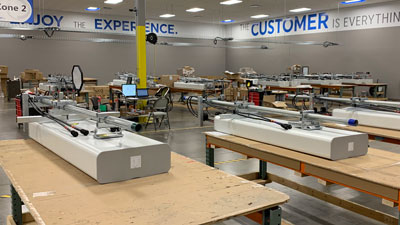Macro Cell Deployment: The AWTI Advantage
April 26, 2021
Macro cells are a major component of the new network deployments in the United States. With over 200,000 macro cells already in place, thousands of additional macro cells are projected to be built every year for the foreseeable future.
Meeting this enormous demand will require a substantially different approach than what is used for current network deployments. It requires a new methodology where the majority of the work is completed in a central, controlled environment, and allows equipment to be deployed into the field that has already been installed and integrated into the network.
Assemble Wire Test and Integrate – or AWTI – is the exact methodology that solves this need.
AWTI Process for Macro Cell Deployment
It is estimated that 28% of network deployments do not receive the materials required for the installation. This can result in both material excesses and shortages.
Material excesses frequently result in excess material spend and redistribution of Service Provider-owned materials to third parties. Material shortages, defects, and damage cause costly redeployments and delays at approximately 18% of all field installations.
By performing a last-minute validation of the appropriateness of materials ordered against the most current design, late design changes and scoping errors can be corrected and adjusted quickly. This ensures that materials received precisely match the materials ordered and delivered to the field.
Production Line Assembly
AWTI in a production facility has many advantages over traditional field installations. The primary benefit is overall cost.
The average tower climber makes $28 per hour while the average skilled warehouse assembler makes around $15 per hour. At a typical wireless field installation, as much as 70% of the work performed on site consists of low to semi-skilled assembly and installation tasks. An average tower crew costs approximately $3,800 per day and will frequently spend at least two days performing ground based low-skilled assembly work before starting the highly skilled tower climbing that drives their premium labor rates.
A production environment can react to changes much faster. Changes to the design or installation standards can be implemented immediately, and proximity to inventory ensures changes do not impact production times. Immediate communication and implementation of changes also improves quality and reduces the amount of rework. Immediate access to Skilled Technicians and Engineers allows for rapid resolution of technical problems and complications found during installation or integration processes.
Material Movement Efficiency
The efficiencies of AWTI improve material handling on several fronts.
Performing a significant amount of the assembly and installation at a central location reduces the volume of raw materials sent to the field.
By uncrating and installing equipment in racks, and assembling components, a typical field installation can see up to a 40% reduction in the footprint of shipments to the site. This footprint reduction also leads to a reduction of the overall amount of waste that needs to be disposed of by field installation resources.
In many cases, the need to locate and travel (multiple times) to dumps or recycling centers can be eliminated.

Rapid Remedy and Repair
When damaged or defective equipment goes into the field, countless hours can be lost to replacement and returns processes.
In a typical network deployment, it is estimated that 6% of all installations are impacted by damaged or defective equipment. While equipment defects are rare (less than 3%), damaged equipment is much more common. In most cases, it is nearly impossible to identify the source of the damage once the equipment has traveled to the field. Equipment damaged in the field is rarely identified as such, and very difficult to prove. In an AWTI environment, damage can be immediately identified and remedied.
Proof of condition can also be established for all equipment going to the field, allowing Service Providers to increase the accountability of field installation resources.
AWTI processes also allow for rapid resolution of equipment defects. Proximity to inventories allows for the immediate engagement of returns processes and replacement spares. It can also provide for more consistent error and defect reporting, leading to faster OEM problem resolution. Better engagement of the returns process also significantly reduces the likelihood that replacement spares become redundant capital purchases.
Effective Resource Utilization
As previously mentioned, highly skilled field installation resources are difficult to find and maintain, and expensive to deploy. Tower crews can be particularly scarce, and their costs can fluctuate wildly based on market demand, geography, and season.
The AWTI model relies on a more available labor pool consisting of semi-skilled technicians and assemblers, all operating out of a central, environmentally controlled location. By transferring as many scope items as possible from highly skilled field resources to a centralized labor pool, there can be significant cost savings. This transfer also allows for the highly skilled resources to focus their efforts on only the skilled activities and tasks in the field and allows them to complete field tasks faster and more efficiently.
AWTI Can Deliver Improved Network Quality
By deploying equipment to the field that has already been assembled, tested, and integrated, field installation resources can simply ‘hot-slide’ new equipment into place for disaster recovery situations or general network maintenance.
No time is lost completing power-on validations, firmware upgrades, or configuration uploads. The new network node can be immediately available for service once it is bolted down, powered up, and backhaul connectivity verified. This can yield significant improvements to overall network outage times and reduces ‘capital in transit’ impacts to the SP’s bottom-line financials.
To learn more and discover how KGPCo’s Assemble Wire Test and Integrate solution can work for your Macro Cell builds contact the KGPCo Wireless Service team.
Learn More
A New Deployment Mindset for Macro Cells
A New Deployment Mindset: Small Cells
How the AWTI Process Can Accelerate Your Small Cell Deployments







